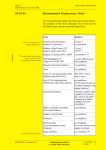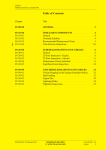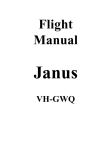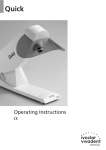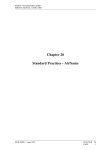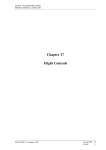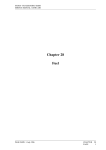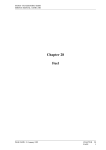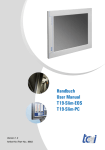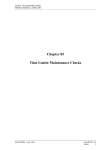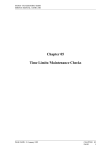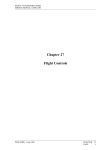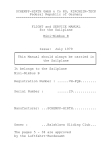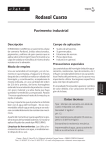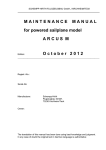Download Chapter 51 Standard Practices and Structures - General
Transcript
EXTRA - FLUGZEUGBAU GmbH SERVICE MANUAL EXTRA 300 Chapter 51 Standard Practices and Structures - General PAGE DATE: 31. January 1995 CHAPTER PAGE 51 1 EXTRA - FLUGZEUGBAU GmbH SERVICE MANUAL EXTRA 300 TABLE OF CONTENTS Chapter Title 51-00-00 51-00-01 GENERAL Access Panel Identification 51-10-00 51-10-01 51-10-02 INVESTIGATION Damage Classification Repair Criteria and Limits 51-30-00 51-30-01 51-30-02 51-30-03 MATERIALS Composite Parts Metal Components Aluminium Components 51-60-00 51-60-01 CONTROL SURFACE BALANCING Weighing and Determination of Control Surface Moments ................................................................................................................ ......................................................................... ............................................................................................ ..................................................................................... ............................................................................ 51-70-02 51-70-03 51-70-04 51-70-05 51-70-06 51-70-07 PAGE DATE: 31. January 1995 6 6 7 8 8 11 12 ......................................................................................................... ..................................................................................................... ............................................................................................ ............................................................................ .................................. ......................................................................... 51-70-00 51-70-01 3 3 REPAIRS Repair of Reinforced Glass and Carbon Fibre Components Repair of Sandwich Material Repair of Laminates Repair of Spars Structural Repair of Steel Components Painting of Composite Parts Aluminium and Steel Components Refinishing ................................................................................................................ ...................................................................... ................................................................. ....................................................................................... .................................................................................................... ........................................ ................................................................... ................... CHAPTER PAGE 14 14 18 18 20 25 29 30 31 32 51 2 EXTRA - FLUGZEUGBAU GmbH SERVICE MANUAL EXTRA 300 51-00-00 GENERAL 51-00-01 Access Panel Identification For the Extra 300 all removable covers and fairings are defined as access panels (refer to Figure 1 and the adjacent chart). If maintenance or repair is not restricted to a small area it is advisable to remove all access panels before beginning work or checks. NOTE Access panels partly overlap. Remove the front panels first. All panels are screwed. For the removal/installation of the wing tip panels refer to Chapter 57. Prior to unscrewing of the air inlet screen remove bottom half of the engine cowling not to lose the attachment stopnuts and washers. PAGE DATE: 31. January 1995 CHAPTER PAGE 51 3 EXTRA - FLUGZEUGBAU GmbH SERVICE MANUAL EXTRA 300 GENERAL Access Panel Identification Access Panel Identification Figure 1 PAGE DATE: 31. January 1995 CHAPTER PAGE 51 4 EXTRA - FLUGZEUGBAU GmbH SERVICE MANUAL EXTRA 300 GENERAL Access Panel Identification Position Item PAGE DATE: 31. January 1995 1 Top half of the engine cowling 2 Tank covering sheet 3 Turtle deck 4 Tail fairing 5 Tail cone access panel (RH) 6 Tail side skin (LH/RH) 7 Rear side skin (LH/RH) 8 Cuff (LH/RH) 9 Wheel speed fairing (LH/RH) 10 Front side skin (LH/RH) 11 Bottom half of the enginge cowling 12 Air inlet screen 13 Spinner 14 1. bottom covering sheet 15 2. bottom covering sheet 16 LH wing tip panel 17 LH outbourd access panel 18 LH inboard access panel 19 3. bottom LEXAN-window 20 4. bottom covering sheet 21 RH inboard access panel 22 RH outboard access panel 23 RH wing tip panel CHAPTER PAGE 51 5 EXTRA - FLUGZEUGBAU GmbH SERVICE MANUAL EXTRA 300 51-10-00 INVESTIGATION 51-10-01 Damage Classification WARNING All damage of composite parts must first be classified by qualified personnel. In case of doubt with regard to the classification of damage, if a clear definition of the extent of damage is not possible, or if a repair of damage inspite of the valid manufacturer documentation is doubtful, contact EXTRA-FLUGZEUGBAU GmbH. WARNING Only the Damages Classes 2, 3 and 4 may be repaired by qualified personnel. In case of Damage Class 1 it has to be contacted EXTRA-FLUGZEUGBAU GmbH. According to the Luftfahrt-Bundesamt (Federal German Aviation Authority) four damage classes are defined: Damage Class 1: Large scale destruction requiring a partial reconstruction of the component or large scale repair. Each destruction over 300 mm diameter and each damage of a spar is a large scale destruction. EXTRA-FLUGZEUGBAU GmbH has to be contacted prior to repair. Damage Class 2: Damage to primary structures and to secondary structures to the following extent: Holes and fractures extending through a sandwich component and a scale under 300 mm diameter. Damage Class 3: Damage to primary structures and to secondary structures to the following extent: Small holes or fractures in the external covering layers, if not accompanied by damage to supporting layers or internal covering layers. PAGE DATE: 31. January 1995 CHAPTER PAGE 51 6 EXTRA - FLUGZEUGBAU GmbH SERVICE MANUAL EXTRA 300 Damage Class 4: INVESTIGATION Damage Classification Erosion, scratches or nicks not accompanied by fractures or breakages. Damage to fairings belong to this class. 51-10-02 Repair Criteria and Limits IMPORTANT ll damage of composite parts must first be classified prior to repair. Refer to Chapter "51-10-01 Damage Classification". IMPORTANT Only the Damages Classes 2, 3 and 4 may be repaired by qualified personnel. In case of Damage Class 1 it has to be contacted EXTRA-FLUGZEUGBAU GmbH. The decision whether to repair or replace a major unit of structure will be influenced by factors such as time and labor available, and by comparison of labor costs with the price of replacement assemblies. Past experience indicates that replacement, in many cases, is less costly than major repair. Certainly, when the aircraft must be restored to its airworthy condition within limited time, replacement is preferable. PAGE DATE: 31. January 1995 CHAPTER PAGE 51 7 EXTRA - FLUGZEUGBAU GmbH SERVICE MANUAL EXTRA 300 51-30-00 MATERIALS This Section describes metallic and non-metallic materials used in the repair of the Extra 300 and gives the sources of supply (manufacturers and supplier). 51-30-01 IMPORTANT Composite Parts Only approved materials have to be used for the repair of composite parts. Epoxy-system Manufacturer: RÜTGERS, BAKELITE Aktiengesellschaft,Varzinerstr. 49, D-47138 Duisburg 12, Germany Resin: Hardener: Rütapox L20 Rütapox SL Ratio of comp.: 100 parts L20 / 34 parts SL (weight ratio) Glass fibre fabrics Manufacturer: INTERGLAS, Interglas AG Söflinger Straße 246, Postfach 3820, D-89077 Ulm, Germany Style 90070 92110 92125 92140 WLB-No.* US-style LN 9169 weave patterns weigh g/m² 1610 plain 80 none twill 2/2 163 8455160 none twill 2/2 280 8455160 none twill 2/2 390 8.4505.60 8454860 *All glass fabric is made of alkali-free E glass with Volan-A finish or with finish I 550. PAGE DATE: 31. January 1995 CHAPTER PAGE 51 8 EXTRA - FLUGZEUGBAU GmbH SERVICE MANUAL EXTRA 300 MATERIALS Composite Parts Carbon fibre fabrics Manufacturer: CCC, C. Cramer GmbH & Co. KG Postfach 209, D-48619 Heek-Nienborg, Germany Style CCC 447 452 459 WLB-No.* weave US-style DIN 65147 patterns 8,3507;80 weight g/m² 8,3520;80 none plain 160 none twill 2/2 204 - none cross-twil 220 *WLB: Werkstoff Leistungsblatt, according to German standard DIN-WL Glass rovings: Manufacturer: GEVETEX Textilglas-GmbH Postfach 426, D-5100 Aachen, Germany Supplier: Type: Lange & Ritter GmbH Postfach 100321, D-7016 Gerlingen, Germany Vetrotex EC14 - 2400-P185 Carbon rovings: Manufacturer: Tenax Fibers GmbH & Co. KG Kasinostr. 19-21 D-42103 Wuppertal Supplier: Type: PAGE DATE: 31. January 1995 Tenax Fibers GmbH & Co. KG Kasinostr. 19-21 D-42103 Wuppertal TENAX J HTA 5131 1600tex f24000 t 0 (WLB: 8.3614.85) CHAPTER PAGE 51 9 EXTRA - FLUGZEUGBAU GmbH SERVICE MANUAL EXTRA 300 MATERIALS Composite Parts Core material a) PVC Foam: Manufacturer: DIAB Divincell International Gmbh Max-von-Laue-Straße 7 D-30966 Hemmingen, Germany Supplier: Type: see above Divinycell HT 50 b) Honeycomb: Manufacturer: EURO COMPOSITES S.A: B.P.95, Zone Industrielle, L-6401 Echternach / Luxembourg Type: ECA-I-R 4.8-29-R Filler material for resin: Manufacturer: EBERHARD Chemie GmbH Olpener Straße 405, D-51109 Köln 91 (Merheim), Germany Type: - Cotton flakes - Microballoons BJO - 0930 Paint: Manufacturer: GLASURIT GmbH Max-Winkelmannstr. 80, D-48165 Münster/Hiltrup, Germany Supplier: Type: 285-100 929-73 352-91 PAGE DATE: 31. January 1995 WESSELS AG Pagenstecherstraße 121, D-49090 Osnabrück, Germany Glassodur-Rapidfüller AC 85-0100 Glassodur-MS-Härter SC 29-0173 Glassodur-Einstellzusatz SV 41-0391 CHAPTER PAGE 51 10 EXTRA - FLUGZEUGBAU GmbH SERVICE MANUAL EXTRA 300 1006-202/3 Glassit Härterpaste, rot SB 48-3360 929-73 Glassodur-MS-Härter SC 29-0173 352-91 IMPORTANT Glassit Spritzfüller SP 60-7023 948-36 21- 51-30-02 MATERIALS Composite Part Materials Glassodur-PUR-Acryl-Lack AD/AE 2 Glassodur-Einstellzusatz SV 41-0391 Metal Components Only approved materials have to be used for the repair of metal components. Steel tubing: Manufacturer: MHP Mannesmann Hoesch Präzisrohr GmbH Postfach 1713, D-59061 Hamm, Germany Supplier: Type: HEINE+BEISSWENGER Stiftung + CO Postfach 1510, D-70705 Fellbach, Germany WLB 1.7734.4 18mm x 1.0mm, 20mm x 1.0mm, 22mm x 1.0mm, 22mm x 1.5mm, 25mm x 1.5mm Steel sheet metal : Manufacturer: BÖHLER Edelstahl GmbH München, Germany Supplier: Type: PAGE DATE: 31. January 1995 BÖHLER Edelstahl GmbH Hansa Allee 321, D-40549 Düsseldorf, Germany WLB 1.7734.4 1.0mm, 1.5mm, 2.0mm, 3.0mm CHAPTER PAGE 51 11 EXTRA - FLUGZEUGBAU GmbH SERVICE MANUAL EXTRA 300 MATERIALS Metal Components Paint: Manufacturer: GLASURITGmbH Max-Winkelmannstr. 80, D-48165 Münster / Hiltrup, Germany Supplier: Type: 801-1552 Glassofix Grundfüller-EP AC 01-1492 21- Glassodur-PUR-Acryl-Lack AD/AE 2 352-91 Glassodur-Einstellzusatz SV 41-0391 965-32/2 1929-73 51-30-03 WESSELS AG Pagenstecherstraße 121, D-49090 Osnabrück, Germany Glassofix Härter-EP SC 65-0322 Glassodur-MS-Härter SC 29-0173 Aluminium Components Aluminium sheet metal: Manufacturer: Kaiser Aluminium & Chem. Corp. Spokane, Washington Supplier: Type: Westdeutscher Metallhandel Postfach 104245 45141 Essen WLB 3.1364. T3511 or 2024 T3 0.6mm; 0.8mm; 1.2mm Control rod tubings: Manufacturer: Aluminium AG CH-5737 Menziken Supplier: Type: PAGE DATE: 31. January 1995 Karstens & Knauer GmbH&Co D-28865 Lilienthal WLB 3.1354. T3 ø 25x1mm CHAPTER PAGE 51 12 EXTRA - FLUGZEUGBAU GmbH SERVICE MANUAL EXTRA 300 MATERIALS Aluminium Components Paint: Manufacturer: GLASURIT GmbH Max-Winkelmannstr. 80, D-48165 Münster / Hiltrup, Germany Supplier: Type: Primer: 283-150 352-228 Lacquer: WESSELS AG Pagenstecherstraße 121, D-49090 Osnabrück, Germany Glassofix-Grundfüller AB83-1150 Glassofix-Zusatzlösung SC12-0228 21- Glassodur-PUR-Acryl-Lack AD/AE 2 352-91 Glassodur-Einstellzusatz SV 41-0391 1929-73 Glassodur-MS-Härter SC 29-0173 Aluminium hardware metal (brackets, pedestals, castings, etc.): Paint: Manufacturer: Parker & Anchem, Ambler, PA 19002 Supplier: Aircraft Spruce Lacquer: see above Chem. coating: Alodine No. 1201 (MIL-C-5541) PAGE DATE: 31. January 1995 CHAPTER PAGE 51 13 EXTRA - FLUGZEUGBAU GmbH SERVICE MANUAL EXTRA 300 51-60-00 CONTROL SURFACE BALANCING 51-60-01 Weighing and Determination of Control Surface Moments All weighing of control surfaces is performed with surface removed from aircraft. Weighing and determination of control surfaces moments is necessary after repairs or painting. Weigh the control surfaces including the mass balances in disassembled condition. The aileron weight includes the spade. Copy page 31, enter the values (W, m, r) there and check whether the surface weights or moments are within the given tolerances. If they are not, contact the manufacturer for advice. For the determination of control surface moments follow the steps as described below and use two balancing mandrels like shown in the Figure 2: Balancing Mandrels Figure 2 Procedure 1 Remove the control surface (refer to chapter 27). 2 Reinstall the bolts in two brackets. PAGE DATE: 31. January 1995 CHAPTER PAGE 51 14 EXTRA - FLUGZEUGBAU GmbH SERVICE MANUAL EXTRA 300 CONTROL SURFACE BALANCING Weighing and Determination of Control Surface Moments 3 Put the control surfaces on the balancing mandrels (use a wire for the trim tab). 4 Weigh by means of a conventional spring balance (kg/gindication) at the given weighing points (Figure 3) and enter the weight (m) in Figure 4. 5 Measure distance of hinge center line to weighing point (r) and enter the value in Figure 4. 6 Calculate the control surface moment (M) in Figure 4. 7 Reinstall the control surfaces only if the weight and moment values fall within the permissible values stated in Figure 4. PAGE DATE: 31. 1. June January 19961995 CHAPTER PAGE 51 15 EXTRA - FLUGZEUGBAU GmbH SERVICE MANUAL EXTRA 300 CONTROL SURFACE BALANCING Weighing and Determination of Control Surface Moments Determination of Control Surface Moments Figure 3 PAGE DATE: 31. January 1995 CHAPTER PAGE 51 16 EXTRA - FLUGZEUGBAU GmbH SERVICE MANUAL EXTRA 300 CONTROL SURFACE BALANCING Weighing and Determination of Control Surface Moments Permissible Weights and Moments 250 Elevator (incl. mass balance) 200 Rudder (incl. mass balance) 150 Aileron (incl. mass balance and spade) 100 50 0 3.5 3 2.5 2 1.5 1 5 5.5 6 Mass (kg) 6.5 7 7.5 Trim tab 70 80 90 Weights Aileron LH: (W) . . . . . . . . . . kg Rudder: (W) . . . . . . . . . . kg Trim Tab: (W) . . . . . . . . . . kg 100 110 Mass (g) 120 130 140 Aileron RH: (W) . . . . . . . . . . kg Elevator: Moments (W) . . . . . . . . . . kg Aileron LH: (m:) . . . . . . . kg . 9.81m/s2 . (r:) . . . . . . . cm = (M:) . . . . . . . . . . Ncm Elevator: (m:) . . . . . . . kg . 9.81m/s2 . (r:) . . . . . . . cm = (M:) . . . . . . . . . . Ncm Aileron RH: (m:) . . . . . . . kg . 9.81m/s2 . (r:) . . . . . . . cm = (M:) . . . . . . . . . . Ncm Rudder: (m:) . . . . . . . kg . 9.81m/s2 . (r:) . . . . . . . cm = (M:) . . . . . . . . . . Ncm Trim Tab: (m:) . . . . . . . kg . 9.81m/s2 . (r:) . . . . . . . cm = (M:) . . . . . . . . . . Ncm 15. January December 1999 PAGE DATE: 31. 1995 Control Surface Weights and Moments Figure 4 CHAPTER PAGE 51 17 EXTRA - FLUGZEUGBAU GmbH SERVICE MANUAL EXTRA 300 51-70-00 REPAIRS 51-70-01 Repair of Reinforced Glass and Carbon Fibre Components IMPORTANT Repair of composite parts has to be carried out only by qualified and authorized personnel. If the aircraft is damaged, proceed as follows. First conduct a careful visual inspection of the surface and the damaged area. Frequently, the damage extends to futher components, sometimes a fracture will continue invisible beneath the surface. Perform the repair work with utmost care. The external shell of the wing and empannage is stressed; a failure of this bonded structure can lead to an aircraft crash. In order to eliminate dangerous stress concentrations, avoid changes in cross-sectional areas. IMPORTANT The resin-hardener mixture ratio must be precisely maintained (+0.5%). Clean cups and tools must be used. The weight ratio of glass fabric to resin mixture should be approximately 50:50. Immediately prior to applying the wet laminate, sand and vacuum clean the repair area, so that no dirt and dust is involved which could prevent a secure adhesion. WARNING Sanding carbon and glass fibre laminates gives off a fine dust that may cause skin and/or respiratory irritation unless suitable skin and resiration protection is used. WARNING Carbon-tetracloride or Acetone used for cleaning repair areas are flamable liquids and should be used with proper ventilation and safety equipment. IMPORTANT As with plywood grain, the direction of the various fibres (longitudinal or diagonal) is of great importance for the stability. PAGE DATE: 31. January 1995 CHAPTER PAGE 51 18 EXTRA - FLUGZEUGBAU GmbH SERVICE MANUAL EXTRA 300 REPAIRS Repair of Reinforced Glass and Carbon Fibre Components The number of layers required to restore the stability in the damaged area can be taken from the layer sequence/placement plan.(Refer to the respective Chapters) It is necessary to know the number and direction of layers in the damaged area, in order to be able to replace them with the original number. In all cases, the thickness of the laminate has to be measured with a vernier calliper for the exact determination of the laminate tickness. One technique to learn about the number of layers is to burn a small piece taken from the damaged area. The resin will burn off, leaving the glass and/or carbon fabric to be inspected for the number of layers and the type of fabric. Creating a scarfed overlap takes time. Sand away as much of the old material, that the new fabric patches do not project beyond the contour. In order to shorten the curing time, a heater can be used to increase the ambient temperature. CAUTION Too high temperature will cause large air bubbles in the laminate. Local overtemperature can be prevented by using a foil tent which leads the hot air stream. The curing cycle must be maintained as stated. Use a thermometer to monitor the temperature. IMPORTANT After repair of control surfaces, check for proper balance ( refer to chapter 27, Flight Controls). It is recommended to prepare test specimens at the same time as the actual repair is accomplished. These can then be subject to a material test to establish the quality of the laminate in the repaired part. To make this determination valid, the specimens must be assembled with the same style of fabric and resin mixture. Subsequently the specimens must be subject to the curing pressure, temperature and time identical with those in the actual repair. PAGE DATE: 31. January 1995 CHAPTER PAGE 51 19 EXTRA - FLUGZEUGBAU GmbH SERVICE MANUAL EXTRA 300 51-70-02 REPAIRS Repair of Sandwich Material Two types of core materials are used for sandwich on the EXTRA 300: - PVC hard foam - Honeycomb both with glass or carbon fibre shells The following section describes the repair of both types of sandwich. Different processing techniques for these materials, if necessary, are also described. a) Minor surface damage Around a visible crack, the laminate may be separated from the core material. Determine the extent of this area by coin tapping. Remove the separated laminate carefully using a sanding disk, sanding block or a sharp knife. Prepare a scarfed overlap of the laminate around the damaged area. Overlap lenght per fabric layer min. 20 mm; IMPORTANT Ratio (laminate thickness : overlay lenght) min. 1: 50 (refer to Figure 5). Minor surface damage Figure 5 After preparing the scarfed overlap, clean the repair area thoroughly as follows: - Remove the sanding dust with a pneumatic vacuum cleaner - Clean the scarfed overlaps with carbon-tetrachloride or acetone in case of dirt or grease was introdued during the preparation. Damaged core material has to refilled with a mixture of resin and microballoons (weight ratio 100:15). Apply resin mixture PAGE DATE: 31. January 1995 CHAPTER PAGE 51 20 EXTRA - FLUGZEUGBAU GmbH SERVICE MANUAL EXTRA 300 REPAIRS Repair of Sandwich Material to the repair area and lay on fabric in accordance to the layer sequence plans. Ensure to use correct style and direction of fabric. IMPORTANT Repair area must be clean of dirt, dust and grease! Lay out the required number and size of fabric pieces on a piece of colored plastic foil and soak (wet) them with resin mixture, subsequently position them on the repair area. IMPORTANT Remove the plastic foil after each positioning process. For a repair of honeycomb sandwich parts you have to observe the following: The repair area has to be cured under condition of vacuum bagging. For vacuum bagging, proceed as follows: - Apply peel nylon fabric on the last repair fabric layer - Perforate a clean, thin plastic foil with a thick needle (max.spacing of holes: 20mm x 20mm) - mainly in the area of the honeycomb - and lay it on the repair area. - Lay a jute cloth (weave) or equivalent bleeder cloth on this perforated plastic foil. - Lay an air tight plastic foil upon the jute weave and seal their edges to the surrounding surface using an adhesive tape. - Apply suction with a vacuum pump (pressure approx. 0.7 bar/ 10 psi) - Apply the thermal curing cycle.(Refer to Figure 3) - Following the curing cycle remove vacuum bagging material and peel nylon fabric. After the pre-curing period at room temperature, the repaired area has to be cured according the temperature cycle as shown on Figure 6. PAGE DATE: 31. January 1995 CHAPTER PAGE 51 21 EXTRA - FLUGZEUGBAU GmbH SERVICE MANUAL EXTRA 300 REPAIRS Repair of Sandwich Material Curing cycle resin L20/SL Figure 6 After the curing process is completed, the repair area can be sand level to the surrounding area. CAUTION Sand only the edge thickness of repair laminate (refer to Figure 7)! Level Sanding of Surrounding Area Figure 7 NOTE For painting of the repair area refer to Chapter 51-7006. b) Damage of complete sandwich If the inner laminate is also damaged, first remove the upper laminate within the area, where no secure bond connection to the core material is suspected. Trim out the complete damaged portion of core material to a circular or elliptical shape. PAGE DATE: 31. January 1995 CHAPTER PAGE 51 22 EXTRA - FLUGZEUGBAU GmbH SERVICE MANUAL EXTRA 300 REPAIRS Repair of Sandwich Material The damaged area of the inner laminate has to be taken out as well. Make sure not to increase the disbond area by preparing the hole. Preferably use a hand held milling machine. In case of cutting with a saw, the pulsation stress may peel of the inner laminate (secondary damage). If the extent of the disbonded area on the inner laminate exceeds the prepared cut out, increase the cut out of material and upper laminate. Prepare a scarfed overlap of laminate around the circular cut out. Overlap lenght of inner laminate should not be less than 20 mm. IMPORTANT Overlap lenght of the upper laminate should not be less than 1/50; (ratio: laminate thickness / overlap lenght). Prepare a replacement block of core material (foam or honeycomb) with equivalent diameter and thickness. Cut it to fit snuggly in the trimmed hole. In case of foam core, coat one side with a mixture of resin and microballoons (ratio 100:15). Apply prelaminated fabric layers required for the inner laminate on this side of the core filler block. Ensure correct style and direction of fabric. After precuring the laminate at elevated room temperature (30°C), scarf the overlap and sand the upper overlapping core material down, up to the surrounding core material. Subsequently clean the repair area thoroughly as follows: - Remove the sanding dust with a pneumatic vacuum cleaner - Clean the scarfed overlaps with carbon-tetrachloride or acetone in case of dirt or grease was introdued during the preparation. WARNING IMPORTANT PAGE DATE: 31. January 1995 Carbon-tetracloride or Acetone used for cleaning repair areas are flamable liquids and should be used with proper ventilation and safety equipment. Repair area must be free of dirt and grease. Wet all surfaces of the backing plate and the scarfed area with resin mixture. Lay on prelaminated fabric layer in accordance to the layer sequence plan. Ensure correct style and direction of fabric. CHAPTER PAGE 51 23 EXTRA - FLUGZEUGBAU GmbH SERVICE MANUAL EXTRA 300 REPAIRS Repair of Sandwich Material Damage of Complete Sandwich Figure 8 Lay out the required number and size of fabric pieces on a piece of plastic foil and wet them with resin mixture. Subsequently position them on the repair area. IMPORTANT Remove the plastic foil after each positioning process. The repair area has to be cured under condition of vacuum bagging. Proceed as follows: - Apply peel nylon fabric on the last repair fabric layer - Perforate a clean, thin plastic foil with a thick needle (max. spacing of holes: 20mm x 20mm) - mainly in the area of the honeycomb - and lay it on the repair area. - Lay a jute cloth or equivalent bleeder cloth on this perforated plastic foil - Lay a second plastic foil uppon the jute weave and seal their edges to the surrounding surface using an adhesive tape. - Apply suction with a vacuum pump (pressure approx. 0.7bar / 10psi) - Apply the thermal curing cycle - Following the curing cycle carefully remove vacuum bagging material and peel nylon fabric. NOTE After the pre-curing period at room temperature, the repaired area has to be cured according the temperature cycle as shown on Figure 6. After the curing process is completed, the repair area can be sand level to the surrounding area. IMPORTANT PAGE DATE: 31. January 1995 Sand only the edge thickness of repair laminate! CHAPTER PAGE 51 24 EXTRA - FLUGZEUGBAU GmbH SERVICE MANUAL EXTRA 300 REPAIRS For painting of the repair area proceed like mentioned in Chapter 51-70-06. 51-70-03 Repair of Laminates a) Minor damage Scarf the edges of the minor damage area with sandpaper. Minimum lenght of scarf per fabric layer approx. 20 mm; ratio (laminate thickness : scarf lenght) approx. 1: 50. Following the scarf procedure, clean the repair area thoroughly: - Remove the sanding dust with a pneumatic vacuum cleaner - Clean the scarfed overlaps with carbon-tetrachloride or acetone in case of dirt or grease was introdued during the preparation. CAUTION Repair area must be free of dirt, dust and grease. Wet the prepared scarfed areas with resin mixture. Lay on prelaminated fabric layer in accordance to the layer sequence plan. Ensure correct style and direction of fabric. Apply peel nylon fabric on the last repair fabric layer. NOTE Lay out the required number and size of fabric pieces on a piece of colored plastic foil and wet them with resin mixture. Subsequently position them on the repair area. IMPORTANT Remove the plastic foil after each positioning process. CAUTION After the curing process is completed, remove the peel nylon fabric. The repair area can be sand level with the surrounding area. Sand only the edge thickness of repair laminate! Refinish the surface according chapter 51-70-05 Painting. PAGE DATE: 31. January 1995 CHAPTER PAGE 51 25 EXTRA - FLUGZEUGBAU GmbH SERVICE MANUAL EXTRA 300 REPAIRS Repair of Laminates If the extent of the damaged area exceed 10 cm (4 inches) a large damage repair is required. Carefully trim out the damaged portion to a circular or oval shape. Prelaminate a backing plate from two layers of glass fibre fabric and resin mixture, which must be approx. 20 mm larger than the damaged area. Apply peel nylon fabric as external layer. Sandwich the resin wetted layers between two sheets of plastic foil. Work the excess resin out and allow the plate to cure at elevated room temperature for 8 hours on a flat surface or a plasticfoil-covered surface of the proper curvature near the damaged area, or the same location on a comparable undamaged part. Following the curing cycle remove plastic foil and peel nylon fabric. Bond the backing plate to the inside using a mixture of resin and cotton flocks, and adapt to the contour. Cure the bonding at elevated room temperature for 8 hours. Subsequently scarf the edges of the damaged portion with sandpaper. Minimum lenght of scarf per fabric layer approx. 20 mm; IMPORTANT Ratio (laminate thickness : scarf lenght) approx. 1: 50. Following the scarf procedure, clean the repair area thoroughly: - Remove the sanding dust with a pneumatic vacuum cleaner - Clean the scarfed overlaps with carbon-tetrachloride or acetone in case of dirt or grease was introdued during the preparation of the overlap. IMPORTANT Repair area must be free of dirt, dust and grease. Wet all surfaces of the backing plate and the scarfed area with resin mixture. Lay on prelaminated fabric layer in accordance to the layer sequence plan. Ensure correct style and direction of fabric. PAGE DATE: 31. January 1995 CHAPTER PAGE 51 26 EXTRA - FLUGZEUGBAU GmbH SERVICE MANUAL EXTRA 300 REPAIRS Repair of Laminates NOTE Lay out the required number and size of fabric pieces on a piece of colored plastic foil and wet them with resin mixture. Subsequently position them on the repair area. IMPORTANT Remove the plastic foil after each positioning process. The repair area has to be cured under condition of vacuum bagging. Proceed as follows: - Apply peel nylon fabric on the last repair fabric layer - Perforate a clean, thin plastic foil with a thick needle (max. spacing of holes: 20mm x 20mm) - mainly in the area of the honeycomb - and lay it on the repair area. Repair of minor damage Figure 9 b) Large damage If the extent of the damaged area exceed 10 cm (4 inches) a large damage repair is required. Carefully trimm out the damaged portion to a circular or oval shape. Prelaminate a backing plate from two layers of glass fibre fabric and resin mixture, which must be approx. 20 mm larger than the damaged area. Apply peel nylon fabric as external layer. Sandwich the resin wetted layers between two sheets of plastic foil. Work the excess resin out and allow the plate to cure at elevated room temperature for 8 hours on a flat surface or a plasticfoil-covered surface of the proper curvature near the damaged area, or the same location on a comparable undamaged part. Following the curing cycle remove plastic foil and peel nylon fabric. Bond the backing plate to the inside using a mixture of resin and cotton flocks, and adapt to the contour. Cure the bonding at elevated room temperature for 8 hours. PAGE DATE: 31. January 1995 CHAPTER PAGE 51 27 EXTRA - FLUGZEUGBAU GmbH SERVICE MANUAL EXTRA 300 REPAIRS Repair of Laminates Subsequently scarf the edges of the damaged portion with sandpaper. Minimum lenght of scarf per fabric layer approx. 20 mm; IMPORTANT ratio (laminate thickness : scarf lenght) approx. 1: 50. Following the scarf procedure, clean the repair area thoroughly: - Remove the sanding dust with a pneumatic vacuum cleaner - Clean the scarfed overlaps with carbon-tetrachloride or acetone in case of dirt or grease was introdued during the preparation of the overlap. IMPORTANT Repair area must be free of dirt, dust and grease. Wet all surfaces of the backing plate and the scarfed area with resin mixture. Lay on prelaminated fabric layer in accordance to the layer sequence plan. Ensure correct style and direction of fabric. NOTE Lay out the required number and size of fabric pieces on a piece of colored plastic foil and wet them with resin mixture. Subsequently position them on the repair area. IMPORTANT Remove the plastic foil after each positioning process. The repair area has to be cured under condition of vacuum bagging. Proceed as follows: - Apply peel nylon fabric on the last repair fabric layer. PAGE DATE: 31. January 1995 CHAPTER PAGE 51 28 EXTRA - FLUGZEUGBAU GmbH SERVICE MANUAL EXTRA 300 REPAIRS Repair of Laminates - Perforate a clean, thin plastic foil with a coarse needle (max. spacing of holes: 20mm x 20mm) - mainly in the area of the honeycomb - and lay it on to the repair area. - Lay a jute cloth or equivalent bleeder cloth on this perforated plastic foil. - Lay an air tight plastic foil upon the jute weave and seal their edges to the surrounding surface using an adhesive tape. - Apply suction with a vacuum pump (pressure difference approx. 0.7bar / 10psi) - Curing cycle - Following the curing cycle carefully remove vacuum bagging material and peel nylon fabric. After the pre-curing period at room temperature, the repaired area has to be cured according the temperature cycle as shown on Figure 3. After the curing process is completed, the repair area can be sand level to the surrounding area. CAUTION 51-70-04 Sand only the edge thickness of repair laminate! Refinish the surface according chapter: 51-10-09 Painting. Repair of Spars The spars consists of carbon roving caps, glass or carbon fibre webs and PVC foam cores. IMPORTANT PAGE DATE: 31. January 1995 The spars are higly stessed; a failure of this bonded structure can result in loss of the aircraft! In all cases, the repair of a spar must be considered as a large-scale repair with a Damage Class 1 (Refer to Chapter 51-10-01 Damage Classification"). EXTRA-FLUGZEUGBAU GmbH has to be contacted prior to repair! CHAPTER PAGE 51 29 EXTRA - FLUGZEUGBAU GmbH SERVICE MANUAL EXTRA 300 51-70-05 REPAIRS Structural Repair of Steel Components Restoration of a damaged fuselage to its original design strength, shape and alignment involves careful evaluation of the damage, followed by exacting workmenship in performing the repairs. IMPORTANT Should structural repairs practicable on the aircraft be necessary, refer to "Aircraft Inspection and Repair FAA AC 43.13-1A" and "Aircraft Alterations Acceptable Methods, Techniques and Practices FAA AC 43.132A". IMPORTANT Alterations or repair of the airplane must be accomplished by licensed personnel. Consult EXTRAFLUGZEUGBAU GmbH in case of doubt about a repair not specifically mentioned there. NOTE If welding work must be performed, use only the TIG procedure (Tungsten Inert Gas). Use steal welding wire 1.7734.2 for welding additive. PAGE DATE: 31. January 1995 CHAPTER PAGE 51 30 EXTRA - FLUGZEUGBAU GmbH SERVICE MANUAL EXTRA 300 51-70-06 REPAIRS Painting of Composite Parts WARNING Coating materials may cause sensitization by inhalation and skin contact. Hardeners and coating materials ready for use can have an irritant and sensitizing effect upon the skin and respiratory tracts and cause allergic reactions. WARNING Provide for a continuous supply of fresh air during and also after the application, do not inhale the vapours and wear a breathing mask during the spray application of these materials. Persons suffering from an allergy or being prone to diseases of the respiratory tracts must not get in contact with coating materials. Refer to the manufacturer technical information sheet!! After curing cycle the surface of repared area can be sanded with sandpaper (80 grade). Indentations are filled with white polyester filler. Subsequently achieve a surface as uniformly rough as possible using a finer dry sandpaper (150 or 320 grade). Prior to paint application, the surface of the repair area must be cleaned thoroughly of all sanding dust, separation compounds and other foreign materials. Subsequently apply Glassodur Rapid Filler with a spray gun. NOTE The Rapid Filler must be completely dry before the covering paint can be applied. For the final sanding, use 400 grade wet sandpaper to achieve a smooth clean surface. Allow surface to dry. Paint application of Glassodur-Pur-Acryl-Lack AD/AE 21 two component acryl paint is performed with a spray gun. Paint can be mixed with small quantities of reducer. After completion of the painting, polish the repair area. PAGE DATE: 31. January 1995 CHAPTER PAGE 51 31 EXTRA - FLUGZEUGBAU GmbH SERVICE MANUAL EXTRA 300 51-70-07 REPAIRS Aluminium and Steel Components Refinishing Complete procedure necessary to remove existing paint from aluminium and steel components and then to repaint them as described in the following paragraphs. Degreasing WARNING Cleaning solvents can be toxic and volatile. Use only in well ventilated areas. Avoid physical contact with solvent and do not inhale vapors. Keep solvent containers covered when not in use. CAUTION Before stripping parts, remove all fittings, O-rings, nuts, bolts, washers, pistons, bearingcups, etc. 1 Clean all metal parts by immersing in a clean degreasing solution. An alkaline based solution is recommended for aluminium and magnesium parts. 2 Hardened dirt or grease may be removed with soft bristle brush, or by soaking in cleaning solution. 3 Where necessary clean bearing cones carefully in a separate container of clean solvent. CAUTION Do not spin bearing cones with compressed air. 4 After cleaning, thoroughly dry all metal parts with filtered, dry compressed air. 5 It is recommended that all O-rings, backup rings, and wipers be replaced at each overhaul. However, if necessary, O-rings may be reused, but should be put back into position from which removed. 6 Wipe down O-rings, backup rings, wipers, or other rubber parts with a clean dry cloth. Lubricate with a suitable Oring lubricant prior to installation. PAGE DATE: 31. January 1995 CHAPTER PAGE 51 32 EXTRA - FLUGZEUGBAU GmbH SERVICE MANUAL EXTRA 300 Aluminium and Steel Components REPAIRS Refinishing Paint Removal Disassemble components to the level required for repainting, then proceed as follows. WARNING Stripping solvents can be toxic and volatile. Use only in well ventilated areas. Avoid physical contact with solvent and do not inhale vapors. Keep solvent containers covered when not in use. CAUTION Before stripping parts, remove all fittings, O-rings, nuts, bolts, washers, pistons, bearingcups, etc. Parts must be totally immersed in solvent, to maximize cleaning. 1 Degrease part per degreasing paragraph. 2 Totally immerse part in paint removing solvent. Portions not totally covered by solvent will begin to corrode. NOTE Stripping agents are commercially available for removing topcoat and primer. Follow manufacturer's recommendations for use and disposal of stripping solutions. 3 Remove part from solvent and rinse thoroughly with water heated to 160° to 180°F (71° to 82° C). Flush solvent from all cavities and threaded holes where entrapment might occur 4 Thoroughly dry part with filtered, dry compressed air. 5 Where applicable refer to inspections procedures given in the respective chapters for specific parts to locate possible defects. NOTE PAGE DATE: 31. January 1995 Refinishing should be completed as soon as possible; unprotected parts will begin to corrode. CHAPTER PAGE 51 33 EXTRA - FLUGZEUGBAU GmbH SERVICE MANUAL EXTRA 300 Aluminium and Steel Components REPAIRS Refinishing Repainting Paint all surfaces exept those which are subjected to friction (bearing surfaces, anchor bolt bores, etc.). Proceed as follows: 1 Parts to be repainted should be cleaned and stripped per instruction in degreasing and paint removal paragraphs. 2 Aluminium parts should have a protective barrier between the topcoat and base metal. It is recommended they be treated with solutions listed in Chapter 51-30. 3 Apply solution liberally and evenly. Allows it to set from 1 to 5 minutes. The solution must completely wet the surface and overlap onto the adjoining anodize. 4 Remove excess coating by flushing with clean water. 5 Paints parts with one coat of wash primer. Allow to dry thoroughly. 6 Paint parts with one coat of lacquer listed in Chapter 51-30. Allow to dry thoroughly before reassembly. PAGE DATE: 31. January 1995 CHAPTER PAGE 51 34



































